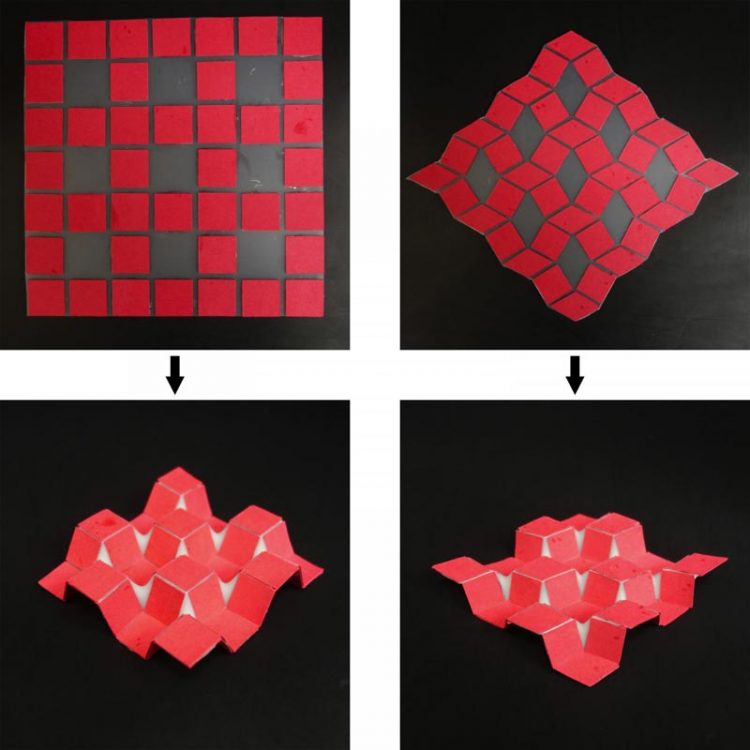New technique uses templates to guide self-folding 3D structures

Researchers from NC State University have developed a new technique to control self-folding three-dimensional (3D) structures. Specifically, the researchers use templates to constrain deformation in certain selected areas on a two-dimensional structure, which in turn dictates the resulting 3D structure of the material. The two-dimensional shapes shown at the top of the image fold themselves into the 3D structures shown on the bottom. Credit: Yong Zhu
The new technique does not rely on cutting or printing on the material, as most other self-folding origami techniques do. It is also different from continuous shape morphing, which is typically controlled by engineering the in-plane strain at various parts of the material. Instead, the researchers applied paperboard sheets to a polymer substrate, forming specific patterns.
“When heat is applied to the polymer, it shrinks,” says Yong Zhu, a professor of mechanical and aerospace engineering at NC State and corresponding author of a paper on the work. “However, the sections of polymer that are attached to the paperboard are restrained from shrinking, causing the overall substrate to bend and curve.”
By varying the pattern made by the paperboard templates, the researchers are able to create a variety of shapes, from simple cones to complex, tiered structures. The self-folding operations can be executed at temperatures as low as 120 degrees Celsius.
“This is a proof of concept paper, and next steps include incorporating functional electronic elements into the material, giving it potential value for manufacturing applications,” says Jianxun Cui, first author of the paper and a postdoctoral researcher at Carnegie Mellon University who worked on this project while a Ph.D. student at NC State.
###
The paper, “Origami/Kirigami Guided Morphing of Composite Sheets,” is published in the journal Advanced Functional Materials. The paper was co-authored by Felipe Poblete, a Ph.D. student at NC State. The work was done with support from the National Science Foundation under the Emerging Frontiers in Research and Innovation program, grant number EFRI-1240438.
Media Contact
All latest news from the category: Materials Sciences
Materials management deals with the research, development, manufacturing and processing of raw and industrial materials. Key aspects here are biological and medical issues, which play an increasingly important role in this field.
innovations-report offers in-depth articles related to the development and application of materials and the structure and properties of new materials.
Newest articles

Properties of new materials for microchips
… can now be measured well. Reseachers of Delft University of Technology demonstrated measuring performance properties of ultrathin silicon membranes. Making ever smaller and more powerful chips requires new ultrathin…

Floating solar’s potential
… to support sustainable development by addressing climate, water, and energy goals holistically. A new study published this week in Nature Energy raises the potential for floating solar photovoltaics (FPV)…

Skyrmions move at record speeds
… a step towards the computing of the future. An international research team led by scientists from the CNRS1 has discovered that the magnetic nanobubbles2 known as skyrmions can be…





















